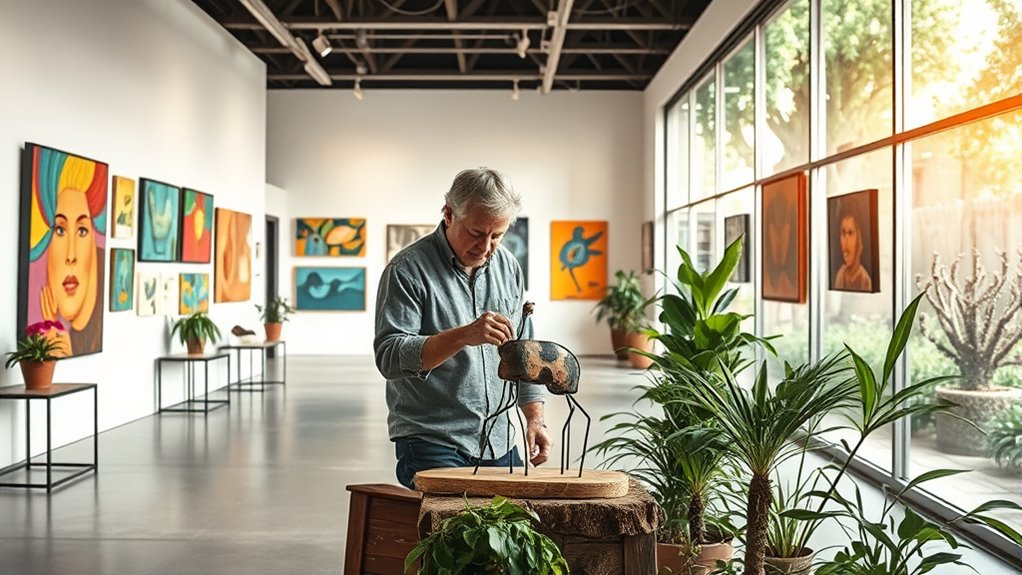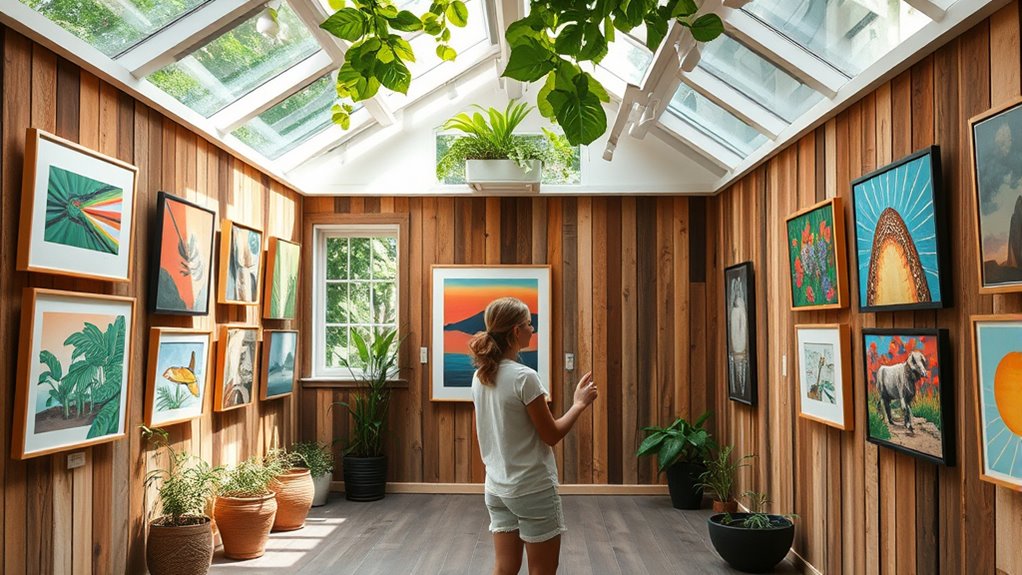To adopt eco-friendly collecting practices, you can focus on choosing sustainable artwork and supporting galleries that prioritize environmentally conscious methods. Consider investing in pieces that emphasize social and environmental themes, and encourage collectors to think about the lifecycle of art. Use energy-efficient lighting and sustainable materials in display spaces. Small actions like these can greatly reduce your environmental footprint and promote a greener art market—discover how you can lead positive change by exploring further.
Key Takeaways
- Promote eco-conscious collecting by prioritizing artworks created with sustainable materials and environmentally friendly techniques.
- Encourage galleries and collectors to implement energy-efficient lighting and sustainable display practices.
- Support artists and exhibitions that emphasize environmental themes and sustainable art practices.
- Advocate for transparency around the lifecycle and provenance of artworks to promote responsible acquisition.
- Foster industry standards that recognize and reward eco-friendly collecting behaviors and sustainable art investments.

Have you ever wondered how the art market can become more environmentally and socially responsible? One way is by embracing art supply recycling. Instead of constantly purchasing new materials, artists and galleries can repurpose and reuse supplies to minimize waste. For instance, old canvases can be repurposed for new works, and leftover paints can be mixed and stored for future use. Art supply recycling not only reduces the environmental footprint but also encourages creative resourcefulness. By adopting these practices, you help cut down on the demand for raw materials, which often require intensive energy and resource extraction. This shift toward reuse aligns with a broader movement within the art community to prioritize sustainability without sacrificing artistic quality.
In addition to recycling art supplies, eco conscious gallery practices play a *vital* role in fostering sustainability. Galleries can implement energy-efficient lighting, such as LED bulbs, to reduce electricity consumption. They might also opt for environmentally friendly cleaning products and sustainable building materials when renovating or constructing new spaces. More importantly, galleries can choose to showcase works that emphasize themes of environmental consciousness or social responsibility, encouraging dialogue around sustainability issues. By adopting these eco conscious gallery practices, you not only minimize environmental impact but also set a powerful example for artists and visitors alike. It’s about creating a space that respects both art and the planet, demonstrating that sustainability and aesthetic excellence can go hand in hand.
Furthermore, engaging your audience in eco-friendly initiatives can amplify your impact. You could host workshops on art supply recycling, teaching others how to reuse and repurpose materials. Promoting awareness about sustainable art practices helps build a community committed to environmental responsibility. Additionally, collaborating with artists who prioritize sustainability in their work emphasizes the importance of eco-consciousness within the art world. These collaborations can inspire collectors to consider the lifecycle of their acquisitions, encouraging them to support artists and galleries that uphold sustainable practices.
Ultimately, making the art market more responsible is about integrating eco-conscious choices into every aspect of collecting and displaying art. From art supply recycling to adopting eco conscious gallery practices, your actions can influence industry standards and inspire others to follow suit. By consciously choosing sustainable materials and methods, you contribute to a healthier environment and foster a more socially aware art community. The shift might seem small at first, but collectively, these efforts can lead to meaningful change, proving that art and sustainability can thrive together. Additionally, understanding the importance of contrast ratio in projectors can help artists and galleries select the right equipment to showcase their work with optimal clarity and depth.
Frequently Asked Questions
How Can Collectors Verify an Artwork’s Eco-Friendly Provenance?
To verify an artwork’s eco-friendly provenance, you should focus on provenance verification by requesting detailed documentation from sellers. Look for eco labels or certifications that authenticate eco-friendly practices. You can also contact certifying organizations directly to confirm the legitimacy of eco labels. By doing so, you guarantee the artwork’s origin aligns with sustainable practices, giving you confidence in its eco-friendly provenance and supporting responsible collecting.
What Are the Costs Associated With Sustainable Art Collecting?
The costs of sustainable art collecting include a thorough cost analysis of eco-friendly artworks and practices, which might be higher upfront due to sustainable materials or ethical considerations. You’ll need to factor in potential premiums for eco-conscious artworks and the investment in provenance verification. While these costs can be significant, they promote responsible collecting and contribute positively to environmental and social sustainability.
Are There Specific Certifications for Environmentally Responsible Artworks?
Like Icarus reaching for the sun, you can aim for certified eco-friendly artworks. Certification standards and eco labeling programs exist to guide your choices, ensuring artworks meet responsible environmental practices. These labels verify that materials and processes align with sustainability goals, making your collection not only beautiful but also ethically sound. Look for reputable eco labels and certification logos to confidently identify environmentally responsible artworks that support a greener art world.
How Does Eco-Friendly Collecting Impact Art Investment Value?
Eco-friendly collecting can positively impact your art investment value by reducing environmental impact and enhancing market perception. When you prioritize sustainable artworks, you demonstrate social responsibility, which appeals to conscious collectors and institutions. This focus can increase demand and potentially raise the value of your collection over time. By aligning with eco-friendly practices, you also future-proof your investments against growing environmental concerns, making your collection more resilient and appealing in the evolving art market.
What Role Do Art Galleries Play in Promoting Sustainability?
Galleries play a pivotal role in promoting sustainability through proactive initiatives and partnerships. By launching gallery initiatives focused on eco-conscious practices, you can inspire responsible collecting. Collaborating with artists who prioritize sustainability helps amplify your message and impact. Your commitment to eco-friendly practices encourages collectors and artists alike to embrace greener choices, making sustainability a central part of the art world’s future.
Conclusion
As you consider adopting eco-friendly collecting practices, you hold the power to transform the art world. Will your choices spark a broader movement toward sustainability, or will old habits persist in hiding the true impact? The future of the art market hinges on what you decide today. Your actions could be the tipping point—are you ready to make a difference that echoes beyond the gallery walls? The next step is yours to take.








